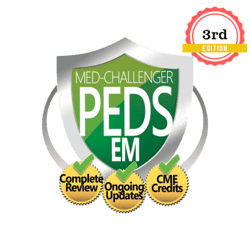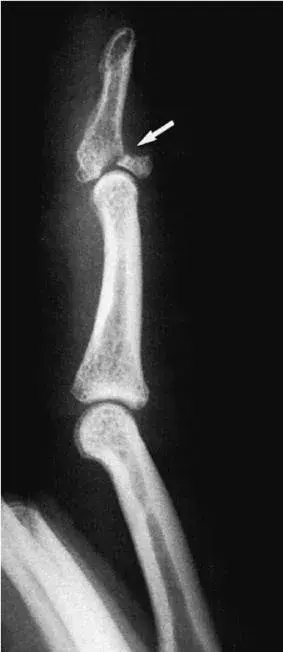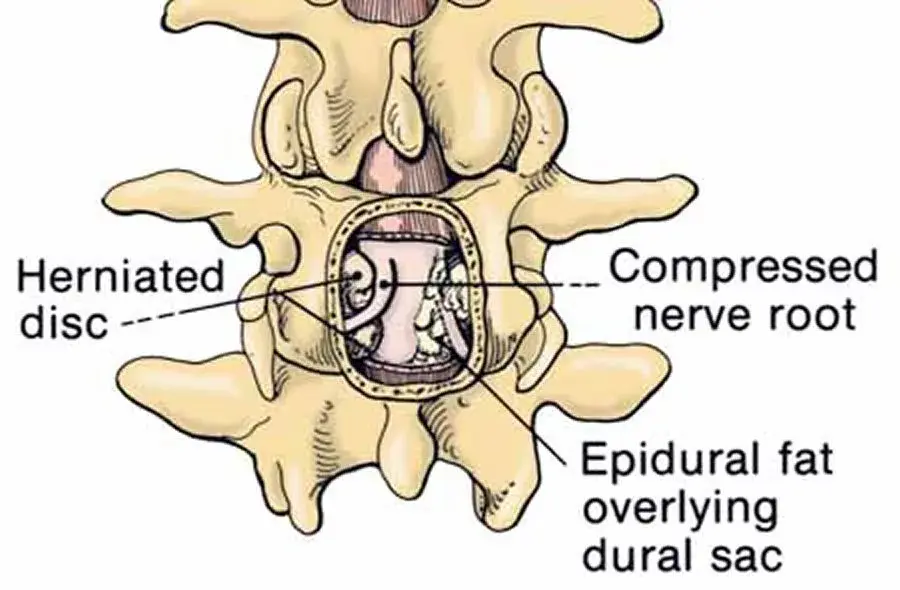Most Missed Question in Pediatric Emergency Medicine This Week
Prioritize airway/breathing/circulation, obtain targeted imaging, and escalate to specialty care for unstable findings; see Core Learning Objectives below for remediation.
A 6 yo girl arrives to the ED via ambulance after she was involved in a motor vehicle crash. EMS reports that she restrained in the middle of the backseat of the vehicle by a lap belt. Driving too quickly in the rain, the driver lost control of the vehicle and collided with a tree just off the road at approximately 55 mph. The patient has had reported loss of consciousness. The patient is currently complaining of abdominal pain and back pain. The patient has the following finding on exam:
 Clinical Photo courtesy of Jeranil Nunez
Clinical Photo courtesy of Jeranil Nunez
Trauma labs and imaging are ordered. A fracture is reported on imaging of the lumbar spine Which of the following is true about your suspected diagnosis?
Answer Options:
A. Concurrent intra-abdominal injuries are uncommon
B. Fracture occurs most commonly in the lower lumbar spine
C. Fracture occurs due to axial loading
D. Treatment is with casting or TLSO bracing if there is purely osseous injury
This vignette tests recognition of the classic pediatric “seat‑belt” or Chance fracture. We want you to link the mechanism (lap‑belt flexion–distraction) to the pattern of bony and soft‑tissue injury. This is a common boards gotcha because the presentation is subtle and because examinees often confuse mechanism, typical level, and management.
Why This Question Is Often Missed
- Confusing mechanism terms (axial loading vs flexion‑distraction). Exam candidates default to familiar crash injuries like burst fractures from axial load.
- Underestimating the importance of ligamentous injury and intra‑abdominal injury risk when seeing a “bony” fracture on CT; that changes management.
What the Distractors Indicate
| Option | What It Tests / Implies | Why It’s Wrong Here |
|---|---|---|
| Concurrent intra‑abdominal injuries are uncommon | Tests knowledge of associated injuries with lap‑belt/Chance fractures. | Wrong: intra‑abdominal injuries (small bowel, mesenteric) are common — reported up to ~50% in older series — so they are not uncommon. |
| Fracture occurs most commonly in the lower lumbar spine | Tests knowledge of typical level of injury. | Wrong: Chance fractures more commonly occur at the thoracolumbar junction (eg L1), not the lowest lumbar levels. |
| Fracture occurs due to axial loading | Tests understanding of injury mechanism. | Wrong: Chance fractures are flexion‑distraction injuries from lap‑belt fulcrum, not pure axial compression (which causes burst/compression fractures). |
| Treatment is with casting or TLSO bracing if there is purely osseous injury | Tests management decision‑making based on stability and soft‑tissue integrity. | Correct: If the injury is purely osseous, neurologically intact, and ligaments are intact, conservative management with casting or TLSO is appropriate. |
High-Yield Pearl
A Chance fracture = flexion‑distraction at the lap belt; check for intra‑abdominal injury and ligamentous disruption; MRI if concern for soft‑tissue injury.
Core Learning Objectives
- Recognize the mechanism and radiographic pattern of a pediatric Chance (flexion‑distraction) fracture and its typical thoracolumbar location.
- Decide between conservative (TLSO/casting) and operative management based on presence of neurological deficit or ligamentous/soft‑tissue instability and screen for concurrent intra‑abdominal injury.
The “Test Trick” at Play
This question tests differential recall of mechanism language while embedding a clinically relevant association (seat‑belt sign + abdominal pain). The trap is the seemingly plausible alternative mechanisms and levels (axial loading, lower lumbar), which many clinicians overapply from other crash injuries. The vignette primes you to think intra‑abdominal injury but the tested single best answer is about spine management — recognize which fact is being asked.
Additional Peds EM Exam Practice Questions and Remediation
(Topics: identification of Chance fracture mechanism/level, associated intra‑abdominal injury, imaging and management decisions; pediatric ED context)
Peds EM Practice Question 1
A 7‑year‑old restrained child involved in a frontal MVC presents with a horizontal abrasion (seat‑belt sign) across the abdomen and midline back pain. CT shows a transverse fracture through the posterior elements and across the vertebral body at T12–L1 without canal compromise. Neurologic exam is normal. The next best step in management is:
A. External fixation in the operating room
B. TLSO brace and bowel evaluation
C. High‑dose IV steroids and immediate fusion
D. Emergent laminectomy and decompression
E. Bed rest only, no brace
Answer and Remediation
- If you chose B: Correct response! This is a classic flexion‑distraction (Chance) injury in a neurologically intact child with apparent osseous fracture only — TLSO and evaluation for intra‑abdominal injury is appropriate.
- If you chose A/C/D/E: Review:
- A: External fixation is not used for stable thoracolumbar Chance fractures without instability.
- C: High‑dose steroids are not indicated for thoracolumbar injuries absent spinal cord injury; not recommended in modern practice.
- D: Emergent decompression is for progressive neurologic compromise, not a stable, neurologically intact patient.
- E: Bed rest alone is insufficient; external immobilization (TLSO/cast) is standard for stable osseous injuries.
Peds EM Practice Question 2
A 9‑year‑old in a MVC was restrained with only a lap belt. He has abdominal tenderness and an L1 fracture suspicious for flexion‑distraction. Which imaging is most useful to evaluate for an associated ligamentous injury of the spine?
A. Plain radiographs only
B. CT lumbar spine only
C. Ultrasound of the abdomen and spine
D. MRI of the spine
E. Repeat CT in 24 hours
Answer and Remediation
- If you chose D: Correct response! MRI is the best modality to evaluate posterior ligamentous complex and soft‑tissue injury in suspected Chance fractures.
- If you chose A/B/C/E: Review:
- A: Radiographs miss soft‑tissue/ligament injuries and have low sensitivity for the full extent of flexion‑distraction injuries.
- B: CT is excellent for osseous detail but less sensitive for ligamentous disruption than MRI.
- C: Ultrasound is not useful for spinal ligament evaluation.
- E: Repeat CT still lacks sensitivity for ligamentous injury; MRI is preferred when ligamentous injury is suspected.
Peds EM Practice Question 3
In pediatric patients with suspected Chance fracture, the most commonly injured intra‑abdominal organ is:
A. Liver
B. Small bowel/mesentery
C. Spleen
D. Kidney
E. Pancreas
Answer and Remediation
- If you chose B: Correct response! Mesenteric and small bowel injuries are classically associated with lap‑belt trauma and Chance fractures.
- If you chose A/C/D/E: Review:
- A: Liver injuries are common in blunt trauma but lap‑belt injuries preferentially injure small bowel/mesentery.
- C: Spleen is common with left upper torso trauma; not the classic lap‑belt pattern.
- D: Kidney injuries can occur, but less specifically tied to lap‑belt flexion injuries.
- E: Pancreatic injury can occur but is less common than small bowel/mesenteric injury in this mechanism.
Peds EM Practice Question 4
A 6‑year‑old with a lap‑belt sign has back pain. Imaging demonstrates a Chance fracture with posterior element distraction and an associated posterior ligamentous complex disruption on MRI. Neurologic exam is intact. Best next step:
A. TLSO brace and observation only
B. Consult spine surgery for operative stabilization
C. Manage non‑operatively but avoid MRI (redundant)
D. Outpatient follow‑up in 2 weeks with no immobilization
E. Epidural steroid injection and early mobilization
Answer and Remediation
- If you chose B: Correct response! Posterior ligamentous complex disruption makes the injury unstable and favors surgical stabilization even if neurologically intact.
- If you chose A/C/D/E: Review:
- A: TLSO is for stable, purely osseous injuries; ligamentous disruption implies instability.
- C: MRI is necessary to diagnose the ligamentous injury; dismissing it is unsafe.
- D: Outpatient follow‑up without immobilization risks progressive deformity and neurologic compromise.
- E: Epidural steroid injections are not appropriate for acute unstable traumatic spinal injuries.
Ped EM Practice Question 5
A 10‑year‑old restrained only by a lap belt collides with a guardrail. He is neurologically intact but has persistent abdominal pain and a thoracolumbar Chance fracture. Which statement is true about long‑term considerations?
A. Chance fractures always heal without deformity with casting.
B. Untreated ligamentous instability can lead to progressive kyphosis and chronic pain.
C. Pediatric spines are immune to post‑traumatic deformity due to growth potential.
D. All Chance fractures require immediate fusion to prevent deformity.
E. Return to sports is safe within 2 weeks if neurologic exam is normal.
Answer and Remediation
- If you chose B: Correct response! Ligamentous instability predisposes to progressive kyphotic deformity and chronic symptoms if not stabilized appropriately.
- If you chose A/C/D/E: Review:
- A: Not always; osseous injuries may do well but ligamentous injuries can cause deformity.
- C: Growth does not protect against post‑traumatic deformity; may even complicate outcomes.
- D: Not all require fusion — only unstable injuries or those with neurologic deficit/failed conservative care.
- E: Early return to sports without adequate healing and immobilization risks worse injury.
Mini Case Discussion Prompt
Compare management and imaging strategies for a suspected Chance fracture in a 6‑year‑old lap‑belted child with isolated back pain versus one with abdominal tenderness and hemodynamic instability. How does the presence of abdominal signs change your priorities and diagnostic pathway?
This question appears in Med-Challenger Pediatric Emergency Medicine 3rd Edition Exam Review with CME
Try for free and save. Ace your exams and meet your CME/MOC requirements.
No matter your program, no matter the size, Med-Challenger for Groups and Institutions can better prepare your program or group, fulfill industry requirements, and increase test scores.








